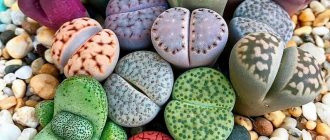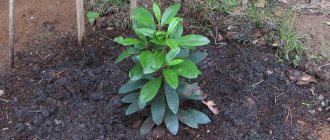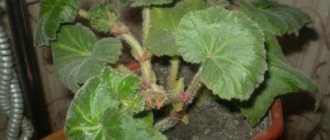They really look like pebbles, which sometimes “crack” and produce either beautiful flowers of the original appearance or new leaves. The lithops flower is considered the most compact indoor plant: each “pebble,” which actually consists of two fused leaf plates of a peculiar shape, reaches a size of up to 5 cm.
Flower growers and collectors value lithops not only for their shape, but also for their interesting colors: they come in green, grayish, bluish, pink, brownish and other shades. A pattern of specks of different sizes and shapes is usually clearly visible on the surface of the leaves. The Lithops flower appears on a short peduncle and can be white, yellow or orange, up to 3 cm in size. In some types of Lithops, the flowers are not only beautiful, but also have a pleasant smell. Flowering in Lithops begins at 3–4 years of age.
The characteristic appearance of Lithops is a consequence of very difficult natural conditions in their habitats: these are hot, arid deserts with sandy or rocky soil, where long dry seasons alternate with periods of rain. In such circumstances, plants have to solve the problem of retaining moisture for a long time and minimizing its loss through the surface of the leaves. And camouflage “like a stone” is a way to protect yourself from being eaten by animals.
It is believed that lithops are sometimes able to change their color and pattern so as to blend in as closely as possible with the background in which they grow (1).
Types and varieties of lithops
More than 30 species of Lithops are found in the wild (2), but only a few of them are grown indoors, including artificially bred hybrid varieties. In general, lithops of different species are similar to each other in terms of their general structural plan and life cycle; only the details differ: final size, leaf shape, size of the growth gap between the leaves, shade of the leaves and flowers of the lithops.
On sale you can often find lithops called “mix”, when a whole set of multi-colored lithops of different types is planted in one container. The care requirements for different types of lithops are common, so the species does not affect the characteristics of keeping these plants. Of the interesting types of indoor lithops flower, the following can be mentioned.
Lithops aucampiae. Most often, this lithops is brown, with characteristic reddish spots, the size of the leaves is about 3 cm. The flower is yellow. There are forms of this lithops with different colors, for example the lilac Kuruman .
Lithops aucampiae. Photo: globallookpress.com
Lithops lesliei. Typically grayish or brownish, with very small, less than 2 cm, leaves. The flower is large, up to 5 cm, yellow, with a faint pleasant aroma. There are forms of Albinica with bright yellowish-green leaves, Venteri which is brighter than the usual Lithops Leslie, and several others.
Lithops lesliei. Photo: globallookpress.com
Lithops fulviceps . Brown lithops with a very interesting pattern that seems to be in relief, and the cylindrical shape of the leaves. The flowers are yellow, up to 3 cm in diameter. There is the Aurea with bright green leaves and yellow flowers, as well as the compact Lactinea , only about 1.5 cm in size.
Lithops fulviceps. Photo: globallookpress.com
Lithops dorotheae . A very small lithops up to 1 cm in size with an unusual pattern on the leaves, perfectly imitating the appearance of feldspar and other stones among which it grows. The flowers of this lithops are bright yellow.
Bromfield's Lithops (Lithops bromfieldii). Pinkish lithops with a beautiful pattern of dark red veins. The flowers of this lithops are white, red, and sometimes orange.
Bromfield's Lithops (Lithops bromfieldii). Photo: globallookpress.com
When and how does it bloom
Codiaum: home care and methods of reproduction
The flowering process itself in these plants can look quite impressive. As they prepare to bloom, the gap between the leaves begins to increase in size. Sometimes this happens literally before our eyes. Then a “tongue” appears from it - this is a sepal; it develops into a real flower on average two weeks from the moment of its first appearance.
Flowering period
It begins in late summer for most species, which is why it is so important to provide good light in August. However, there are also plants with a later flowering period, which occurs in the second half of autumn. Interestingly, the flowers of almost all species bloom by midday. In general, the flowering period of this plant lasts about a week, after which the succulents again turn into stones.
Caring for lithops at home
Caring for lithops is relatively simple (3), if you have a good understanding of the characteristics of the annual life cycle of plants associated with the climate in their natural habitats. Most lithops are “active” only in spring and autumn. In autumn they bloom - the peduncle appears from the gap between the leaves. After flowering, a young pair of leaves appears from the growth gap, which should replace the previous one. In winter, young leaves grow slowly, literally “feeding” on old ones. At the beginning of spring, the old pair of leaves completely dies. In summer, lithops enter a dormant state - in their homeland this is the hottest time when growth is impossible. With the beginning of autumn, the annual cycle resumes.
When caring for a lithops flower, you need to monitor how seasonality manifests itself in a particular plant - indoor species sometimes “go astray” for several weeks. In addition, it is important to know that lithops are “collective” plants that cannot be planted individually. Single lithops develop poorly, bloom at an older age, or do not form flowers at all.
Priming
Lithops require a low-fertility, air- and water-permeable substrate with neutral acidity. Special soil for lithops is found on sale, but very rarely. Flower growers sometimes plant these plants in cactus soil; fine stone chips or pumice can be added to it.
Photo: globallookpress.com
If you prepare soil mixtures yourself, then for lithops you can mix sand, clay and garden soil in a ratio of 1.5:1:1, or sand, pumice and clay soil in a ratio of 1:1:2. It is best to sprinkle the surface of the soil in a pot with small stones: this not only enhances the decorative effect of the lithops, but also creates for them an imitation of natural living conditions.
Lighting
Lithops are native to very hot places with a lot of sun, so they require bright light and long daylight hours. It is believed that the optimal lighting regime for them is several hours of direct sun in the first half of the day and light shading in the second, especially during flowering. Similar conditions are fully ensured on windows of southern, southwestern and southeastern orientation. Lithops are not afraid of direct sun even in extreme heat, but when grown indoors they can suffer from sunburn in the spring, since during the winter they manage to “wean” from direct sunlight. At this time, lithops need to be shaded, gradually increasing their time in the sun.
In winter, plants require additional lighting; the lamp should be installed at a distance of 10 cm from the leaves. Sometimes additional lighting is also necessary in the warm season - for example, if the summer is cloudy and lithops do not receive sunlight for several days in a row. A sign of a lack of light is the stretching of leaf blades and loss of brightness of color.
Temperature
Lithops feel good at room temperature; summer heat does not harm them either. In summer, they can and should be taken out into the open air; daily temperature changes are even beneficial for them: they harden the plants and stimulate growth.
Photo: globallookpress.com
In winter, lithops require cool keeping, the optimal temperature range is from 10 to 14 °C, possibly lowering to 8 °C. It is clear that it is difficult to ensure such a temperature in an apartment, so it is permissible to keep Lithops at 17 – 20 °C. In winter, it is advisable to move the plants away from the cold window glass and place the pot on a stand, since lithops may suffer from proximity to cold surfaces.
Humidity
Lithops do not require high air humidity, so there is no need to spray them. This makes it easier to care for them at home. The only exception may be the period of active growth of young leaves and the death of old ones at the end of winter: at this time the plants are not watered, so if there is a lack of moisture, they can be carefully sprayed, making sure that water does not get into the gap between the leaves. A sign of water deficiency is wrinkling of leaves.
Watering
This is the main difficulty in caring for lithops, since the need for watering directly depends on the phase of the life cycle. In the summer, until about mid-August, the plants are not watered or watered very rarely, once a month and a half. In nature, lithops at this time experience hot and dry times, consuming moisture accumulated in the leaf blades. You can tell that plants need watering by the wrinkling of the leaf blades. If this does not happen, watering is not needed.
Starting from mid-August, lithops need water - in their natural habitats, this is the rainy season. Watering begins with small portions, gradually increasing the amount of water; in the intervals between waterings, the soil should dry out well. Lithops usually bloom at this time. After the flowers appear, watering is gradually reduced again and some time after flowering is stopped completely - the plants begin to prepare for the winter dormant period.
During cold wintering, lithops are not watered. If the plant overwinters in a warm place, you can water it once a season, but very sparingly and carefully, soaking the soil no more than 1 cm deep. In winter, lithops replace old leaves with young ones, sometimes this process is called “molting.”
Photo: globallookpress.com
In the spring, when the old leaves have completely died off, watering is gradually resumed. The most abundant watering is required approximately in the middle of spring, then it is reduced so that by the beginning of summer it stops completely.
When watering, make sure that water does not get on the leaves of the lithops and especially in the gap between them. Only the soil around them needs to be moistened. Water for irrigation should be moderately warm, tap water should be well settled or filtered.
It is important to understand that excess water is much more dangerous for lithops than its lack. These plants are adapted to very dry living conditions, so waterlogging quickly leads to rotting of the roots and leaves. The soil in the lithops pot should be dry most of the time, and after watering it should not remain wet for long.
Fertilizers
Lithops usually do not require fertilizer, especially if the plants are regularly replanted in fresh substrate. If their soil is not renewed, the plants can be fed with special compounds for cacti.
Feeding
Fertilizer is applied in liquid form along with watering, the dosage is 1/2 or even 1/3 of that recommended for cacti. It is clear that you can feed plants only during those periods when they are not dormant and need watering, that is, in spring and autumn. The frequency of feeding is 1 – 2 times per season. Lithops are not fed during flowering.
Trimming
Due to their growth habit, lithops do not require pruning. Removing old dead leaves is not recommended. Also, the flower stalks are not removed after flowering: in place of the flowers, fruits with seeds are formed.
Photo: globallookpress.com
Transplanting “living stones”: detailed instructions
To transplant lithops, you need to take soil, expanded clay (for drainage), a pot, and decorative powder. You need to dry the soil before replanting, that is, do not water it for a couple of days to dry the soil in the pot.
The transplant process goes like this:
- You need to carefully shake it out of the container without damaging the integrity of the lithops.
- Shake off excess soil from the roots, remove rotten and stunted parts.
- Check the succulent for various harmful parasites.
- Pour expanded clay (drainage) onto the bottom of the container so that the holes in the bottom of the pot are closed.
- A layer of soil must be poured onto the drainage so that it completely covers the drainage.
- Place the roots of the plant in the pot, and then carefully cover it with soil in a circle, tapping the pot so that it spreads evenly. Lithops need to be planted to the level of the neck, sometimes a little deeper.
- The top should be sprinkled with powder - special decorative sand and pebbles.
- Immediately after transplantation, you should not water the plant.
After transplantation, the plant must be shaded so that it is not exposed to bright rays of the sun for up to a week. After an adaptation period, you can gradually bring the plant out into the light and resume the normal watering regime.
Root collar rot may occur due to improper planting of the succulent. In this process, it is necessary to pay attention to the fact that only the roots are in the soil, and the neck itself is on top.
You can sprinkle the sides of the lithops with coarse sand to give them stability. The siliceous layer on the surface prevents decay and creates conditions close to the plant’s natural habitat. It is not advisable to water “living stones” before and after planting. Before replanting, you just need to sprinkle the soil with a little water to free the roots from the old substrate.
Transplanted plants should be sent to the greenhouse for 2-3 weeks. Then you need to carefully monitor the soil moisture in the pot and the lighting. Do not allow drafts under any circumstances, otherwise the lithops may die.
Reference! If you plant several lithops in one container, this will only benefit them. Such a union increases the development of the plant and maintains its vitality all year round.
The main rules for caring for lithops are as follows:
- regular ventilation;
- easily permeable, rocky soil;
- sunny side of the plant location;
- rare watering.
Reproduction of lithops at home
Lithops are usually propagated by seeds, since vegetative propagation is very difficult and is only accessible to experienced gardeners. Lithops seeds are available for sale; you can also obtain your own planting material by collecting seeds from existing plants.
Seeds are sown in early spring. The substrate for sowing is 1 part peat and 2 parts perlite, or the same as for adult plants. Before sowing, the seeds are soaked in any stimulant or simply in water for about 6 hours, then, without drying, distributed over a moistened substrate. Light is required for seedlings to emerge, so the seeds cannot be buried; the maximum sowing depth is 1 mm. Lithops seeds are small, so before sowing they can be mixed with sand for convenience. The container with the crops is covered with a transparent lid and kept in a warm place (from 24 °C) in bright light. Daily ventilation and periodic moistening of the substrate from a fine spray bottle are mandatory.
The time of emergence of seedlings is from 1 to 4 weeks. The lid from the mini-greenhouse is removed only a month after their appearance; young plants need high air humidity. When the seedlings reach a height of 1 - 1.5 cm, the surface of the soil can be covered with small pebbles or expanded clay of the finest fraction.
Plants grown from seeds become similar to lithops only at 4–6 months of life, when their first true leaves form. In the first year they are not planted; transplantation is possible only after wintering, in early spring.
Caring for a lithops flower in the first years of life is the same as for an adult. Flowering can be expected in 3–5 years.
Diseases and pests: causes and methods of control
When creating favorable conditions and proper care, lithops are rarely susceptible to disease.
Shedding
This is not a disease, but a natural process, an amazing feature of a stone flower, when new leaf plates grow in place of old leaf plates. This phenomenon occurs in winter, during the period of drying and dormancy. Young Lithops can molt up to three times a year.
Withers
If the plant is at rest and begins to wither, then most likely the process of molting has begun.
Why did the leaves become soft?
The softness of the leaves was probably caused by watering at low temperatures. If, moreover, the cactus begins to rot, it will not be easy to save. Try stopping watering. If the soil is waterlogged, it is better to replant the flower in dry soil rather than lose it. Place the plant in a dry and warm place. Adjust humidity.
Leaves are drying
In this species, drying is associated with the biological process of renewal. During one annual cycle in the autumn-winter period, the leaves of an adult plant dry out and become thinner, giving life to new growth.
Mealybug
The appearance of a mealybug cannot go unnoticed. This is a sucking insect measuring from 3 to 12 mm and white in color. It multiplies quickly. Causes severe damage to the plant.
Attention! If you find a pest, be sure to quarantine the plant, as the worm may spread to neighbors.
To get rid of a pest:
- Wipe the plant with a cotton swab moistened with alcohol or laundry soap.
- Then treat with one of the drugs: Aktara, Confidor, Mospilan, Fitoverm, Tanrek or Calypso according to the instructions on the package.
- Repeat the treatment three times to destroy newly hatched individuals.
For repeated treatments, we recommend changing the insecticide. If you prefer folk remedies, try an infusion of yarrow or an aqueous solution of garlic and soap. For prevention, wipe the plant periodically. The pest does not settle on clean surfaces. And also clean the stones from dry residues.
Rot
Rot enters the plant through small cracks and literally eats it from the inside. A flower may rot if it was bought in a store, and you cannot definitely know what stage it is in or whether it has shed. Perhaps it was necessary to refrain from watering during this period of time.
If rot is noticed in time, cut off the affected area and treat it thickly with a fungicide. Then dry it. Theoretically, it can be saved.
Lithops are not yet very common and popular. Due to its exotic origin, attractive appearance, variety of colors, unpretentiousness and wonderful flowering, the plant has every chance in the near future to win the sympathy of amateur flower growers.
Lithops transplantation at home
Lithops grow slowly and require replanting no more than once every 3 to 4 years. They are usually replanted at the end of the winter dormancy period. The plant is removed from the pot, the roots are lightly shaken off the ground and inspected. The root system of Lithops consists of a long tap root and numerous branching lateral roots. If these roots are damaged during transplantation or rotten, they can be removed - the plant easily tolerates such operations. The taproot should be handled carefully; when transplanting into a new pot, care must be taken that it does not bend or form loops and is positioned as vertically as possible.
Photo: globallookpress.com
If you are replanting a lithops colony of several pieces, the distance between them should be at least 2 cm. When pouring soil into a new pot, you need to make sure that no voids form between the plants. The soil can be pressed down a little with your fingers, but it cannot be compacted. The neck of the plant (the place where the leaves turn into the root) can be located slightly below the ground level in such a way that after filling the surface with gravel, 3/4 of the height of the leaves is above the surface. Transplanted plants are watered for the first time only after a few days.
If the plant was purchased in a store, it must be replanted immediately, regardless of the time of year and phase of its life cycle. The transport substrate in which lithops are sold is usually not suitable for long-term cultivation, so the harm from being in such soil will be greater than from untimely replanting.
Reproduction methods
There are two main ways to propagate lithops - by seeds and shoot cuttings. Traditionally, the second option is considered the simplest. However, some experts believe that only growing lithops from seeds at home will help you better understand them and get the most beautiful specimens.
Germination of seeds
The lithops seed remains viable for a very long time. A number of studies have shown that when stored in a dry place, even after 20 years, seeds can germinate.
Important ! Of course, the ideal place to store them is in a fruit that looks a bit like a capsule.
But most often they are removed from there and dried on a paper napkin. These plants can be sown at any time of the year, but it is best to take into account the natural characteristics of their development.
The step-by-step algorithm will be similar to germinating any other seeds:
- small plastic containers are selected for sowing,
- fill the pots with substrate for succulents, only sifted more thoroughly than usual,
- the seeds are distributed evenly over the surface of the substrate,
- sprinkle them with a thin layer of the same soil,
- Cover the pots with plastic wrap to create a small greenhouse.
Lithops seedlings
Lithops are easy to grow from seeds. Once every two days, the described crops need to be “ventilated” by opening the film and lightly sprayed with water. If the plant feels well, its leaves will be smooth. Regardless of the variety, they will have a darker or brownish tint. Too soft and bright green leaves indicate the weakness of the “living stone”.
Lithops diseases
With good care, the Lithops flower does not get sick, but with excessive or improper watering it can become affected by rot. This is the most common disease of the Lithops flower, especially among beginner succulent lovers. If, during watering, water gets on the leaves and in the gap between them, the above-ground part of the plant may rot. With excessive watering, lithops suffer from root rot.
In the first case, it is very difficult to save the lithops. If the roots are damaged, stop watering, remove the plant from the pot and remove all rotten roots. In case of severe damage, you can wash the root system with a solution of potassium permanganate. After this, the plant is transplanted into fresh soil.
Content
- Lithops - care and cultivation
- Lithops life cycle
- Soil and replanting lithops
- Reproduction of Lithops
Lithops in nature live on rocky and desert terrain, merging with the surrounding landscape, sometimes completely immersed in sand or stones, this determines the peculiarities of their structure. The body of each plant consists of one or more pairs of swollen, fleshy, almost fused leaves at the base, oppositely attached without a petiole to the root; they do not have a stem as such. The acute lack of water in the desert requires young plants to “save” on plant tissue and limit themselves to only two leaves and a root system. The leaves are thick, capable of storing enough water for the plant to survive during the month-long dry period.
In the hollow between the leaves there are meristem cells from which flowers and new leaves are formed. They are gray-green on the sides, lighter on top - partially or completely translucent leaf windows. Often the entire leaves are below the ground surface and only the leaf windows remain in the light - it is through them that the processes of gas exchange and photosynthesis occur. Mimicry of Lithops: Their shape, size and color make them resemble small stones in their natural habitat, and the name "living stones" is fully justified. However, among these succulents there is a huge variety in size and color, leaf gap shape; size and color of flowers. Here are some common types at home:
- Beautiful lithops Lithops bella - forms a group of several pairs of identical “stone” leaves, up to 3 cm high and up to 2.5 in diameter. The color of the leaves is brownish-yellow. The flowers are white, sometimes with a slight aroma.
- Divided lithops Lithops divergens - forms a group of several pairs of leaves, not of the same size, from 1 to 3 cm in height. The gap between a pair of leaves is deep. The leaves are green, with large gray-green spots on the upper, slightly oblique surface. The flowers are yellow.
- Lithops salicola - forms a whole campaign of several pairs of gray leaves, about 2-2.5 cm tall and the same diameter. The gap between a pair of leaves is not deep. The upper surface is almost flat, olive green with dark green spots. The flowers are white.
- Lithops pseudotruncatella - forms a small group of several pairs of leaves, not of the same size, from 1 to 3 cm in height and from 1 to 3 cm in diameter. The gap between a pair of leaves is deep. The leaves are grey, brownish or pinkish. The upper almost flat upper surface has a linear or dotted dark pattern. The flowers are bright yellow.
Lithops contain toxic substances and pose a danger to young children, who are still at the age when they put everything in their mouth to try.
By the way, in addition to the genus Lithops, plants of the closely related genus Pleiospilos Pleiospilos have a similar appearance of living stones. They are distinguished by the hemispherical shape of the leaves, as if swollen, and in addition, they form vegetative shoots from the root system, so one plant can consist of several shoots; lithops do not form such shoots. Pleiospilos is called living granite.
Lithops pests
The pests of lithops are the same as those of other indoor plants, most often they are mealybugs and spider mites.
If strange whitish lumps, plaque or cobwebs appear on the surface of the leaves, you need to carefully examine the lithops for pests. In case of minor damage, mechanical removal of parasites helps: the leaves of the lithops can be thoroughly wiped with a damp cloth or washed very carefully, being careful not to wet the soil too much. If there are a lot of pests, you need to use any suitable preparation: Actellik, Aktara, Fitoverm (4).
Possible problems
When growing lithops at home, problems may arise such as:
- Shrinking of foliage . This is due to the fact that the process of changing fading leaves has gone wrong.
- Wrinkling of leaf plates . This indicates an acute lack of moisture, which can be observed during the dormant period. This problem may also be associated with the appearance of spider mites.
- The appearance of rot on the roots . The plant remains in a moist soil mixture containing peat for a long time.
- Leaf blades swell and rupture . Excessively frequent or excessive watering.
- Brown spots appeared on the foliage . Occurs when watering rules are violated.
- The pattern on the foliage becomes faded . The plant suffers from excessively poor lighting.
- Lack of flowering . There are too many nutrients in the substrate or the rules for maintaining the succulent during the dormant period were violated.
- Pests . Root scale insects, spider mites and fungus gnats can settle on the bush.
Rules of care
In the middle zone, the period of stone growth is from April to October. Dormancy begins in November and lasts until March; by the beginning of the new growing season, molting ends. The website flowery-blog.ru will tell you about the content in different periods.
Temperature and lighting
During the growing season, lithops need active sunlight, otherwise the stem will not form correctly. The place where miracle cacti are kept should be well lit and ventilated; stagnant air and high humidity provoke rotting. New plants need to be acclimated to the sun gradually, shading them during the midday hours so that the surface of the leaves does not get burned due to unaccustomment.
✿











